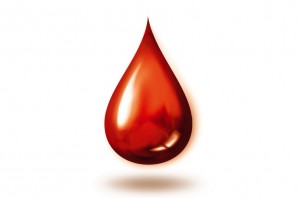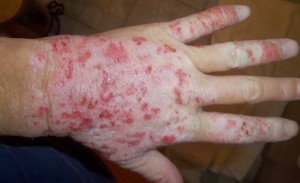תזריע
Parshat Tazria
Wayyiqra (Leviticus) 12:1-13:59

And YaHuWaH spoke to Mushah, saying,“Speak to the children of Yashar’al (Yisrael), saying, ‘When a woman has conceived, and has given birth to a male child, then she shall be unclean seven days, as in the days of her monthly separation she is unclean.- Wayyiqra (Levitivus) 12:1-2
This Torah Portion is called תזריע Tazria which means “she conceived.”
Brit Milah (Circumcision)
Wayyiqra (Leviticus) 12:3 ‘And on the eighth day the flesh of his foreskin is circumcised.
This sign of the covenant was first given to Abraham the forefather, passed down through Yitshaq (Isaac) and through Yaacob (Jacob) and his twelve sons. Here YaHuWaH is reaffirming the covenant he established in the past, the covenant of blood. Every male is to be circumcised on the eighth day. This is actually being spoken on the eighth day of the inauguration of the kohenim (priests) hence the name Shemini (eighth) of the previous Torah Portion. It does not matter if the eighth day of life happens to be on the weekly Shabbath or on a moed (appointed time), chag (festival) or any other occasion, the covenant in the foreskin must be performed on the eighth day. The number eight symbolizes new beginnings. Vitamin K, which is needed to clot blood, is low in the first seven days of life resulting in the likelihood of hemorrhaging. However on the eighth day Vitamin K will be at it’s maximum peak, making it the best of all days for circumcision on a scientific level.
Korbanot (slaughter offerings) for birth
Wayyiqra (Leviticus) 12:4‘And she remains in the blood of her cleansing thirty-three days. She does not touch whatever is set-apart, and she does not come into the set-apart place until the days of her cleansing are completed.
If a daughter is born, the mother is טָמֵא tame’ meaning “impure” or “unclean” for fourteen days, followed by sixty-six days additional.
At the conclusion of these periods that the mother is טָמֵא tame’ , forty days for the birth of a boy and eighty days for the birth of a girl, the woman who gave birth must bring a lamb for an ascending offering and a pigeon or turtle dove for a sin offering. However, if she cannot afford a lamb, she brings a bird instead.
We see this example in the life of Yahuwshuwa HaMashyach (The Messiah):
Luke 2 21And when eight days were completed for Him to be circumcised, His Name was called Yahuwshuwa, the Name given by the messenger before He was conceived in the womb.22And when the days of her cleansing according to the Torah of Mushah were completed, they brought Him to Yerushalayim to present Him to YaHuWaH 23 as it has been written in the Torah of YaHuWaH, “Every male who opens the womb shall be called set-apart to YaHuWaH” 24and to give an offering according to what is said in the Torah of YaHuWaH, “A pair of turtledoves or two young pigeons.”
צָרַעַתTzaraat (“leprosy”)
Wayyiqra (Leviticus) 13: 2“When a man has on the skin of hisbody a swelling, a scab, or a bright spot, and it shall become on the skin of his body like a leprous infection, then he shall be brought to Aharon the priest or to one of his sons the priests.3 “And the priest shall look at the infection on the skin of the body. And if the hair on the infection has turned white, and the infection appears to be deeper than the skin of his body, it is a leprous infection. And the priest shall look at him, and pronounce him unclean.
צָרַעַת Tzaraath appears as discolored flesh, with hair that has turned white. שְׂאֵת se’eth or a swelling is the first quality to look for when dealing with Tzaraat. סַפַּחַת Sapachath can be an eruption, scab or lesion. The term בַּהֶרֶת bahereth is used to to describe a bright spot. Tzaraat is described as נֶגַע Nega meaning “plague”, but also means a mark or spot on the flesh. If בַּהֶרֶת bahereth,”is not deeper in appearance than the skin, and its hair has not turned לָבָן laban meaning white,” the Kohen (priest) is to quarantine the person for seven days. After seven days if the bright patch of flesh has spread, the person is pronounced unclean although if it has not, the afflicted person is quarantined for an additional seven days. If the wound appears to be diminishing then the announcement is made that it is but a scab or eruption and not Tzaraat. The two witnesses of Tzaraath or “leprosy” must be present or there is no Tzaraath. The hair turning לָבָן laban meaning white within the infected region is the major sign.
Wayyiqra (Leviticus) 13:6 “And the priest shall look at him again on the seventh day and see, if the infection has darkened, and the infection has not spread on the skin, then the priest shall pronounce him clean. It is a scab, and he shall wash his garments and be clean.7 “But if the scab spreads further over the skin, after he has been seen by the priest for his cleansing, he shall be seen by the priest again.
There is however an exception to this rule:
12 “And if leprosy breaks out all over the skin, and the leprosy shall cover all the skin of the infected one, from his head to his foot, wherever the priest looks,
13 then the priest shall look and see, if the leprosy has covered all his body, he shall pronounce the infected one clean. It has all turned white, he is clean.14 “But the day raw flesh appears on him, he is unclean.
However if there is a scab or abruption or any raw flesh he is unclean.
There are three signs of tzaraat which are hairs on the afflicted area turning white, the bright patch spreading or an appearance of raw flesh inside the afflicted area.
Patches appearing within the hairline on the head are deemed unclean if the hair is yellow, rather than white. When the patch has a direct association with a wound or burn different laws apply.
If the spot is בֶּהָרֹת כֵּהֹות לְבָנֹת behroth kehoth labanoth meaning “a spot with diminished white coloration.” It is considered as a בֹּהַק bochaq or a freckled spot. This is not Tzaraath only a minor skin disorder. A loss of pigmentation alone cannot constitute Tzaraath. There are many skin disorders that change the coloration of flesh but do not spread, we know Tzaraath is a disease that can be spread and his highly contagious.
הַצָּרוּעַ Ha’tsarua “The Leper”
Wayyiqra (Leviticus) 13:45 “As for the leper who has the infection, his garments are torn, and his head is uncovered, and he has to cover his upper lip and cry, ‘Unclean! Unclean!’46 “He is unclean – all the days he has the infection he is unclean. He is unclean, and he dwells alone, his dwelling place is outside the camp.
HaMetzorah. has often been translated “the leper”. According to Torah the Tsaraat, which has been called leprosy, can infect people, the leprosy would show up in spots of dried up ashy flesh that would have white hairs or yellow if in the head. Raw pieces of flesh would often manifest in these places. This disease is very much like leprosy but actually the infection itself can cover a broader area. This particular word Tsara is very specific and due to the fact that it is often used in judgment for slander or related sins it is seen as a very “spiritual” concept not just a physical one. The infection of Tsaraat rendered a man or woman tame’ or “unclean”. They could not live in the city, but dwelt outside the city, covering their lips if one approached and they would cry out “tame’, tame’” or unclean, unclean. Even to this day there are leper colonies in many locations in the world to keep this devastating disease from spreading.
A “leprous” garment
Wayyiqra (Leviticus) 13:47 “And when a garment has an infection of leprosy in it, in a woollen garment or in a linen garment,48 or in the warp or in the weft of linen or wool, or in leather or in any leather-work,49and the infection shall be greenish or reddish in the garment or in the leather, or in the warp or in the weft, or in any leather object, it is an infection of leprosy and shall be shown to the priest.
Just as the Kohen (Priest) quarantines a human who has an infection, he also quarantines the garment for seven day. If the spot spread he shall burn that garment, however if the spot has not spread, the garment is to be washed and quarantined yet seven more days. If after seven days the spot appears to have faded, the area is ripped out and the garment is potentially spared.
YaHuWaH sometimes used “leprosy” as a means of punishment for one who has spoken evilly or has the bad tongue called lashon hara in Hebrew. Miriam, Mosheh’s sister was struck with leprosy for speaking against Mosheh as we read in another Torah Portion, thankfully she was healed and restored by YaHuWaH’s compassion. May we learn to guard those things we speak because they not only affect others but they may infect us. Leprosy can have horrible disfiguring effects. It can be very hard to even view such human suffering. The status of being a Leper was the most horrible and wretched, yet when we read our Scripture we see the Ha’Mashyach, The Messiah- Yahuwshuwa healed the lepers and had mercy on them. How amazing it is that the King of the Universe, YaHuWaH is rich in compassion and loving kindness, in so much that he sent his Son to lead our hearts to repentance!




